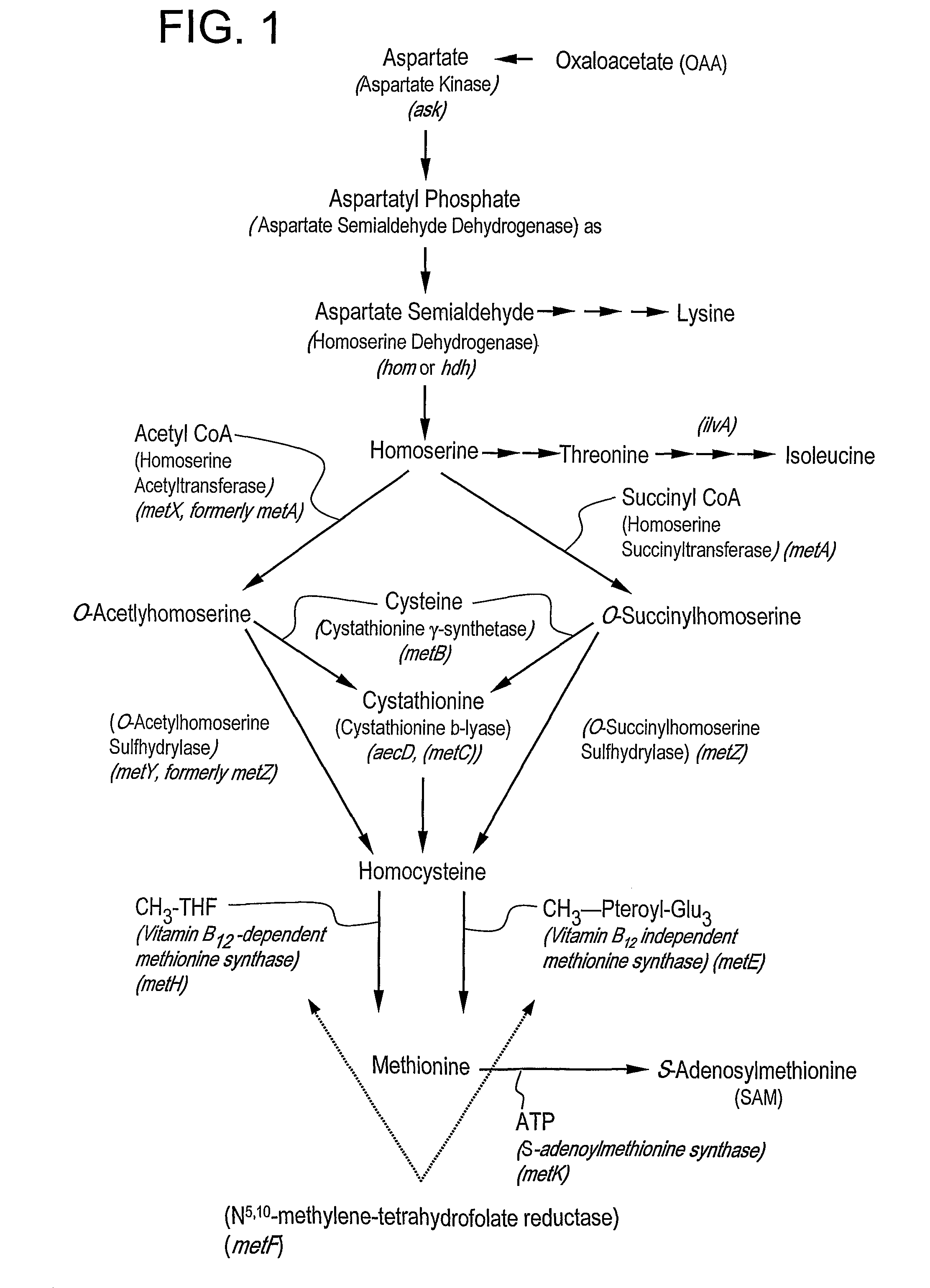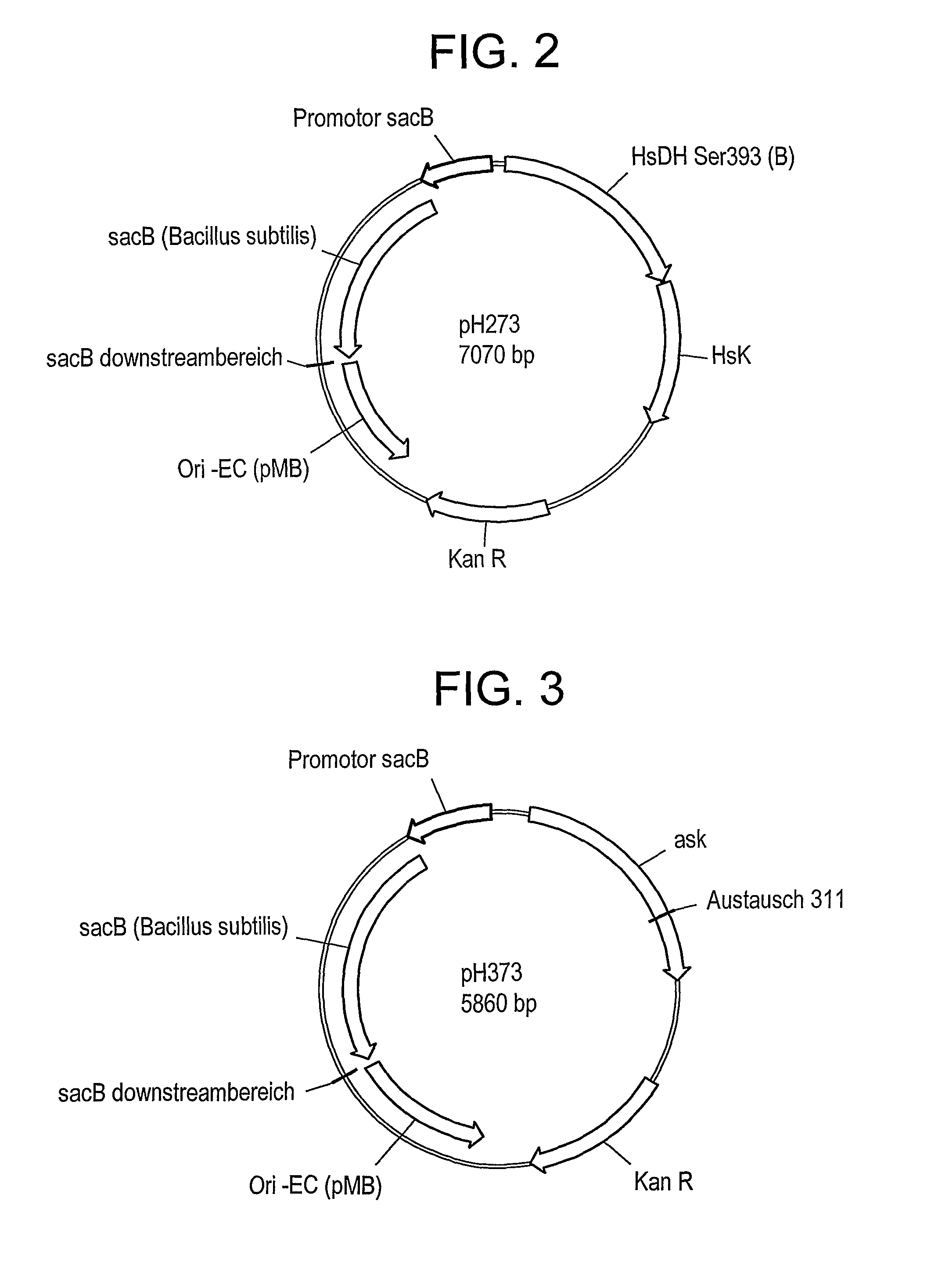Use of dimethyl disulfide for methionine production in microoraganisms
a technology of dimethyl disulfide and methionine, which is applied in the field of use of dimethyl disulfide for methionine production in microoraganisms, can solve the problems of large excess of unused compounds in the process, explosive gas that is easy to oxidize, and toxic, and achieve the effect of reducing sulfa
- Summary
- Abstract
- Description
- Claims
- Application Information
AI Technical Summary
Benefits of technology
Problems solved by technology
Method used
Image
Examples
example 1
Generation of the M2014 Strain
[0111]C. glutamicum strain ATCC 13032 was transformed with DNA A (also referred to as pH273) (SEQ ID NO: 1) and “Campbelled in” to yield a “Campbell in” strain. FIG. 2 shows a schematic of plasmid pH273. The “Campbell in” strain was then “Campbelled out” to yield a “Campbell out” strain, M440, which contains a gene encoding a feedback resistant homoserine dehydrogenase enzyme (homfbr). The resultant homoserine dehydrogenase protein included an amino acid change where S393 was changed to F393 (referred to as Hsdh S393F).
[0112]The strain M440 was subsequently transformed with DNA B (also referred to as pH373) (SEQ ID NO:2) to yield a “Campbell in” strain. FIG. 3 depicts a schematic of plasmid pH373. The “Campbell in” strain was then “Campbelled out” to yield a “Campbell out” strain, M603, which contains a gene encoding a feedback resistant aspartate kinase enzyme (Askfbr) (encoded by lysC). In the resulting aspartate kinase protein, T311 was changed to I3...
example 2
C. glutamicum Methionine Auxotrophs Incorporate Dimethyl Disulfide into Methionine
[0129]In order to determine whether C. glutamicum has the ability to incorporate DMDS into methionine, a deletion of metF in strain M2014 (described in Example 1) was constructed. M2014 was transformed with plasmid pOM86 (FIG. 9) (SEQ ID NO:8) to yield a “Campbell in” strain. The “Campbell in” strain was then “Cambelled out” to yield a “Campbell out” strain named OM63. To determine whether this methionine auxotroph, OM63, could utilize DMDS to synthesize methionine, test tube cultures of OM63 and the parent M2014 were assayed for growth by measuring OD at 600 nm. The cultures were grown in Methionine-free medium (for recipe, see below), methionine-free medium supplemented with methionine, or methionine-free medium supplemented with various different amounts of DMDS (Aldrich Catalog No. 32,041-2). This experiment was designed to determine whether DMDS can cross the membrane of the bacterium, become redu...
example 3
Development of a Delivery System of DMDS to C. glutamicum for Incorporation into Methionine
[0157]As discussed above, DMDS is toxic if added directly to liquid cultures at amounts greater than about 0.06%. In order to overcome this problem, a delivery system that would allow the slow release of DMDS into solution over time was sought. Amberlite™ XAD4, a beaded macro-porous polystyrene resin, referred to hereafter as “XAD4”, was chosen as a delivery system because it is inert, able to adsorb small hydrophobic organic compounds, is capable of being wetted by water, and has a high surface area and small pore size.
[0158]A test tube experiment was performed in order to determine the maximal amount of DMDS that can be adsorbed by XAD4 and still allow growth. To this end, test tube experiments using 5 ml of medium were performed on OM63 and M2014. Each test tube contained 100 μl of a 50% suspension (v / v) of XAD4 and either methionine-free medium, methionine-free medium supplemented with met...
PUM
| Property | Measurement | Unit |
|---|---|---|
| boiling point | aaaaa | aaaaa |
| temperatures | aaaaa | aaaaa |
| temperatures | aaaaa | aaaaa |
Abstract
Description
Claims
Application Information
 Login to View More
Login to View More - R&D
- Intellectual Property
- Life Sciences
- Materials
- Tech Scout
- Unparalleled Data Quality
- Higher Quality Content
- 60% Fewer Hallucinations
Browse by: Latest US Patents, China's latest patents, Technical Efficacy Thesaurus, Application Domain, Technology Topic, Popular Technical Reports.
© 2025 PatSnap. All rights reserved.Legal|Privacy policy|Modern Slavery Act Transparency Statement|Sitemap|About US| Contact US: help@patsnap.com



